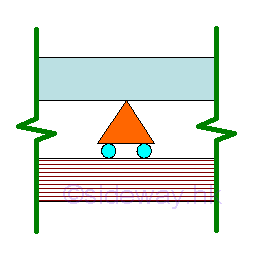 Sideway
BICK BLOG from Sideway
Sideway
BICK BLOG from Sideway
|
Link:http://output.to/sideway/default.asp?qno=120800022 Forces Convention, Types of Supports & Beams Internal Forces in BeamsBeam is one of the most common structure member used in structure for supporting vertical loads which are perpendicular to the axis of the beam. Usually the axial forces of internal forces along the axis of the beam can be ignored as there is either no horizontal load acting on the beam or the horizontal loads can be neglected. Therefore, the internal forces in beam are shear and bending memont only. However, when the applied forces to the beam is not perpendicularl to the the axis of the beam, the internal axial forces should also be considered. Shear and Bending Moment
Consider there is only vertical loading acting on a long straight prismatic bar with uniform cross-sectional area throughout the beam length, the equilibrium equations are 
Since there is no axial force in the beam, the internal forces in a beam is shear and bending moment. 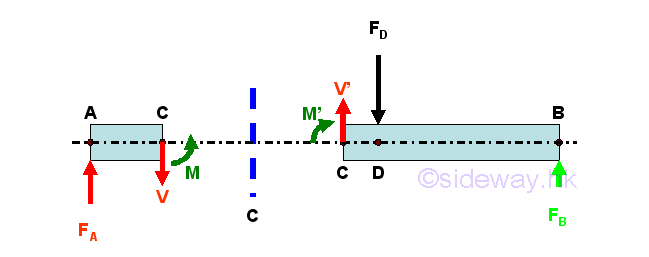
Consider the member section AC of length LAC, the internal forces at point C are 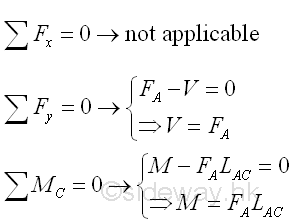
Conventions of Internal ForcesIn general, the length, measured from point A on the left to point C on the right, is considered as a positive length, the external applied force FA, pointing upward is also considered as a force in positive sense and the produced moment due to the external force FA about point C is in negative sense. The direction of internal forces at point C of beam section AC can then be defined by assuming the beam section AC is fixed at pont C. Therefore the positive signed shear V of negative sense in downward direction and the positive signed bending moment M of positive sense in anticlockwise direction are directed at point C of the beam section AC. And the internal forces at point C of the beam section CB can then be defined as internal force of equal in magnitude and opposite in sense using the equilibrium equations at point C of an beam AB in equilibrium or by direct calculation thruough setting up equilibrium equations of beam section CB. According to the convention of the internal forces used in the free body diagrams, the calculated values from the two free body beam sections are the same for the internal forces, since the senses of the internal forces are represented by the standard conventions used in the free body diagrams, i.e. a positive calculated values implies correct sign conventions used in both free body diagrams and a negative calculated value implies incorrect sign conventions used in both free body diagrams, but internal forces in both force diagrams are still equal in magnitude but opposite in sense. Imply 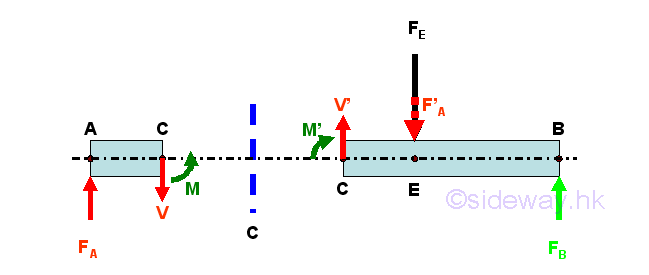
Types of Beam SupportsThere are several common types of support used in beam design for engineering structure design. The beam supports are Hinged Support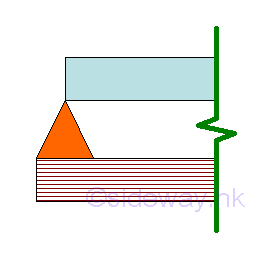
A hinged support is a simple end support at an end of a beam at which there may be slope, but no displacement is allowed. Roller Support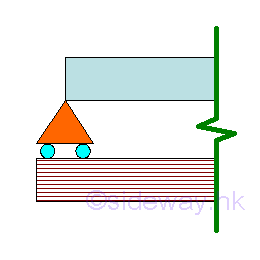
A roller support is a simple end support at an end of a beam at which there may be slope, but no displacement is allowed. Fixed Support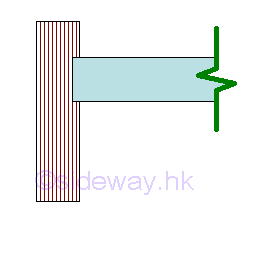
A fixed support is an fixed end support at an end of a beam at which no slope and no displacement is allowed. Free End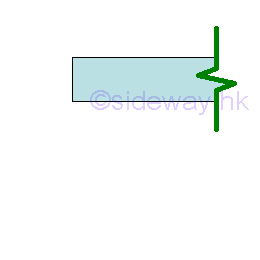
A free end does not have any support or constraint at an end of a beam at which both slope and displacement is allowed. Interior Support
An interior support can be a hinged or roller support located between ends of a beam at which slope is continuous from one side of the support to the other, but no displacement is allowed. Intenal Hinge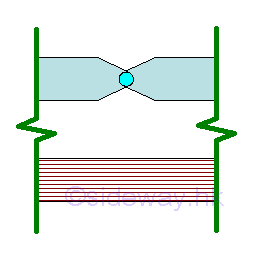
An intenal hinge is a hinge linkage located between ends of two separate beams at which there may be discontinuous slope from one side of the hinge linkage to the other, and the allowed displacement on both sides of the hinge linkage separating the two beams is continuous. Types of BeamsBeam can be named according to how the beam is supported. The distance L between two supports is the span of the beam for supporting loads. The common types of beams are Simply Supported Beam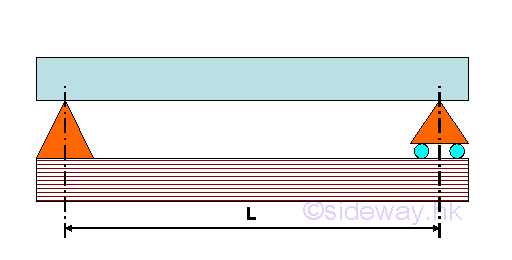
A simply supported beam is supported by a hinged support at one end of the beam and a roller support at another end of the beam. Overhanging Beam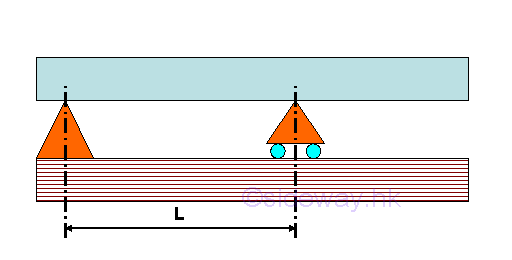
A overhanging beam is supported by a hinged support (or roller support) at one end of the beam and a roller support (or hinged support) at the another side of the beam which is located away from the another end of the beam. Cantilever Beam
A cantilever beam is supported by a single fixed support at one end of the beam only and the another end of the beam there is a free end without any support or constraint. Continuous Beam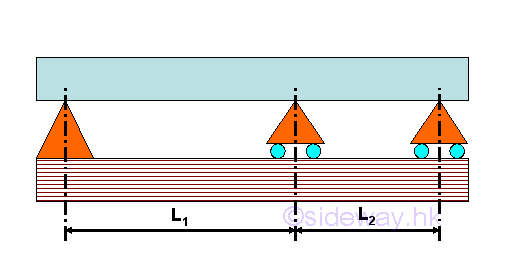
A continuous beam is supported by more than two supports along the length of a beam. In general, a continuous beam is supported by a hinged support at one end of the beam, a roller support at another end of the beam, and one or more roller supports are used between the two end supports. Fixed Beam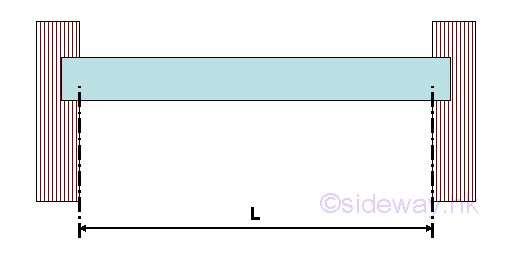
A fixed beam is supported by two fixed supports at both ends of the beam. Cantilever with simply supported Beam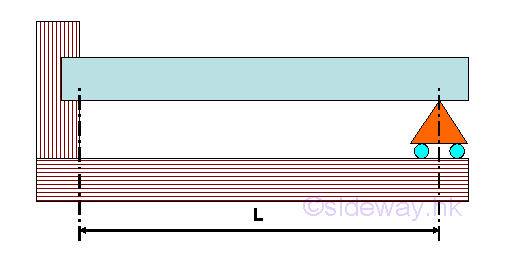
A cantilever with simply supported beam is supported by a fixed supports at one end of the beam and a roller support at another end of the beam. Hinge Connected BeamsHinge connected beams is a single continuous structure by connecting two or more different kinds of supported beams end to end together by hinges. For example, a hinge connected beam with simply support beams connected by internal hinge 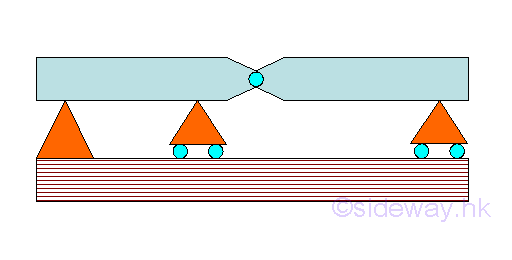
Or, a hinge connected beam with fixed beam and simply support beam connected by internal hinge 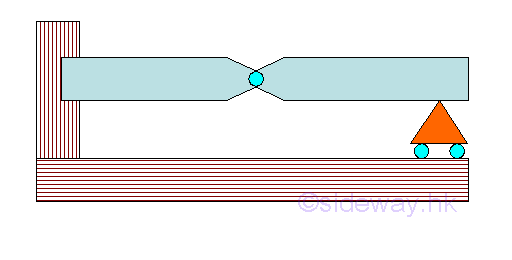
Loads and ReactionsLoads are applied along the span of a beam. In general, the loads considered in static are the concentrated load P and distributed load W. Concentrated load is the one which can be considered as acting at a point although the load is distributed over a small length of the beam in practice. Distributed load is the one which can not be considered as acting at a point because the load is spread over a considerable length of the beam. The distributed load is usually expressed as load w per unit length. The distributed load is called uniformly distributed load when the load w per unit length is a constant or uniform from point to point over the lengh of load distributed. And those distributed loads with varying loading from point to point over the lengh of load distributed are grouped as varying distributed load, e.g linear varying distributed load. 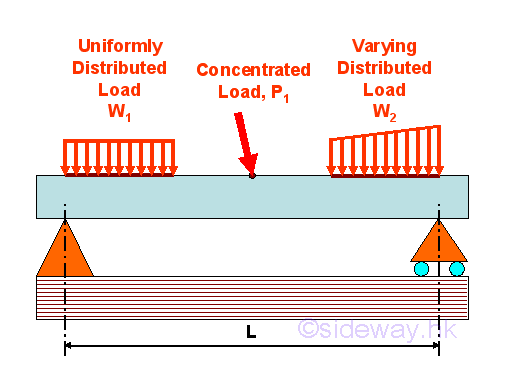
Supports commonly used for the support and connection of beams are the hinged support, roller support, fixed support, and the internal hinge connection. If the total unknown reactions involved in all supports are three unknowns only, the reactions will be statically determinate. Therefore, simply supported beam, overhanging beam and cantilever beam are statically determinate beams. If the total unknown reactions involved in all supports are more than three unknowns, the reactions will be statically inderterminate. Since only three unknowns can be determined by static methods, methods of statics is not sufficient to determine the reactions. Therefore, continuous beam, fixed beam and cantilever with simply supported beam are statically indetermine beams. In order to determine the reactions for statically indetermine beams, additional equations can be taken from the relationships based on the properties of the beam and the resistance to bending under the applied loads. If there are totally only two unknown reactions involved in all supports, the beam is not stable for any applied loads and the beam is partially constrained only. Therefore beam supported by two rollers is partitally constrained. The beam is stable when the applied loads is vertical and the beam will move when the horizotal components of the applied loads is not equal to zero. Therefore in practice, a horizontal restraint is usually used in one support to restrain the beam from rotating or moving horizontal. Link:http://output.to/sideway/default.asp?qno=120800023 Shear and Bending Moment Diagrams of Concentrated Applied Loads Internal Forces in BeamsThe shearing forces and bending moments in a statically determinate beam can be determined by the equilibrium equations. Using the standard convention, the distribution of internal forces in a beam can be represented graphically by plotting the values of shear or bending moment against the distance from one end of the beam. Shear and Bending Moment DiagramsInternal Forces in a Cantilever Beam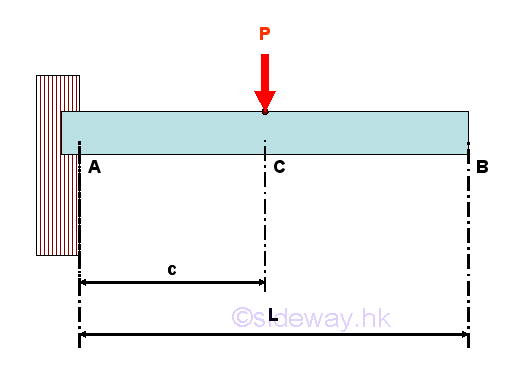
For example, consider a simple cantilevel beam with one applied load applied around the middle of the beam. The free-body diagram of the entire beam is 
The reactions at the fixed support can be determined by the equilibrium equations. 
Internal forces can be determined by dividing the beam into two separated free body. Selecting a point D between A and C, i.e. A<D<C 
Consider the member section AD of length d, the internal forces at point D are 
Point D is a random point between A and C. The shear force V is a constant and is equal to P between point A and point D. And bending moment M is a linear function of point D. Therefore bending moment M=-Pc at point A and bending moment M=0 at point C. Selecting another point E between C and B, i.e. C<E<B 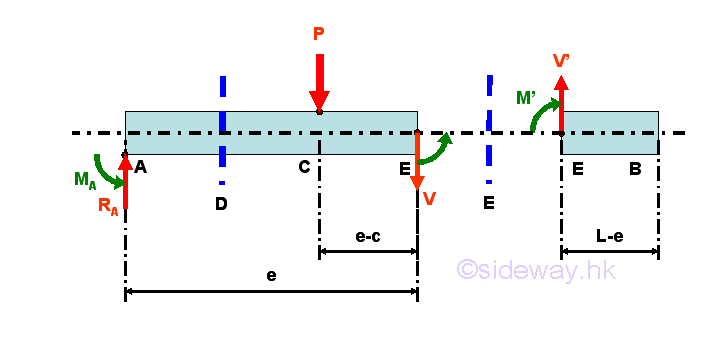
Consider the member section EB of length L-e, the internal forces at point E are 
Point E is a random point between C and B. Both the shear force V and bending moment M is equal to zero between point C and point B. Shear Diagram
Bending Moment Diagram
Internal Forces in a Simply Supported Beam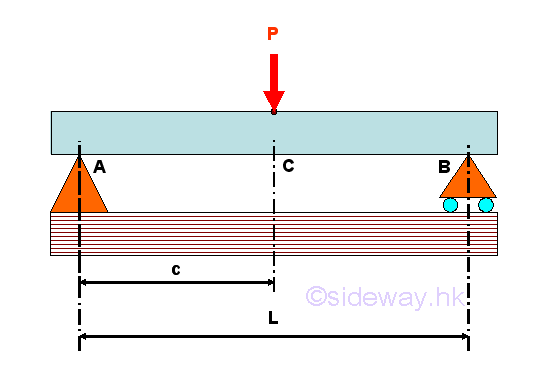
For example, consider a simply supported beam with one applied load applied around the middle of the beam. The free-body diagram of the entire beam is 
The reactions at the hinged and roller supports can be determined by the equilibrium equations. 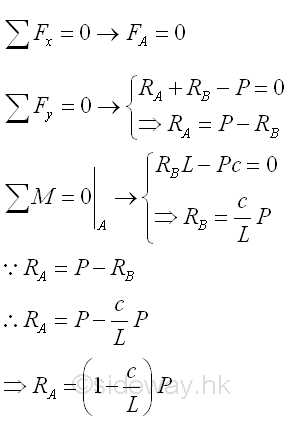
Internal forces can be determined by dividing the beam into two separated free body. Selecting a point D between A and C, i.e. A<D<C 
Consider the member section AD of length d, the internal forces at point D are 
Point D is a random point between A and C. The shear force V is a constant and is equal to (1-c/L)P between point A and point C. And bending moment M is a linear function of point D. Therefore bending moment M=0 at point A and bending moment M=(1-c/L)Pc at point C. Selecting another point E between C and B, i.e. C<E<B 
Consider the member section EB of length L-e, the internal forces at point E are 
Point E is a random point between C and B. The shear force V is a constant and is equal to -(c/L)P between point C and point B. And bending moment M is a linear function of point E. Therefore bending moment M=(1-c/L)Pc at point C and bending moment M=0 at point B Shear Diagram
Bending Moment Diagram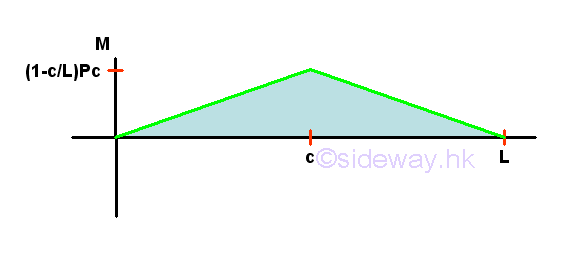
Internal Forces in a Overhanging Beam
For example, consider a overhanging beam with two applied load applied around the middle and the free end of the beam. The free-body diagram of the entire beam is 
The reactions at the roller and hinged supports can be determined by the equilibrium equations. 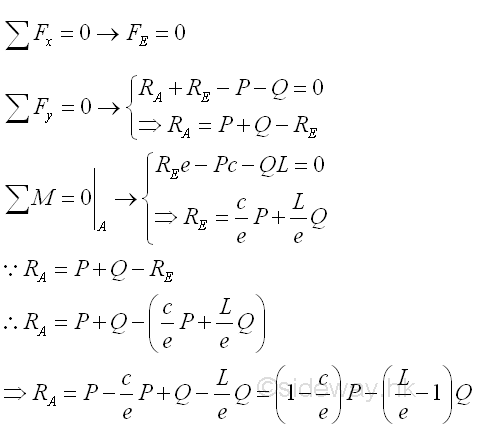
Internal forces can be determined by dividing the beam into two separated free body. Selecting a point D between A and C, i.e. A<D<C 
Consider the member section AD of length d, the internal forces at point D are 
Point D is a random point between A and C. The shear force V is a constant and is equal to ((1-c/e)P-(L/e-1)Q) between point A and point C. And bending moment M is a linear function of point D. Therefore bending moment M=0 at point A and bending moment M=((1-c/e)P-(L/e-1)Q)c at point C. Selecting another point F between C and E, i.e. C<F<E 
Consider the member section AF of length f, the internal forces at point F are 
Point F is a random point between C and E. The shear force V is a constant and is equal to (-(c/e)P-(L/e-1)Q) between point C and point E. And bending moment M is a linear function of point F. Therefore bending moment M=((1-c/e)P-(L/e-1)Q)c at point C and bending moment M=-Q(L-e) at point E. Selecting another point G between E and B, i.e. E<G<B 
Consider the member section GB of length L-g, the internal forces at point G are 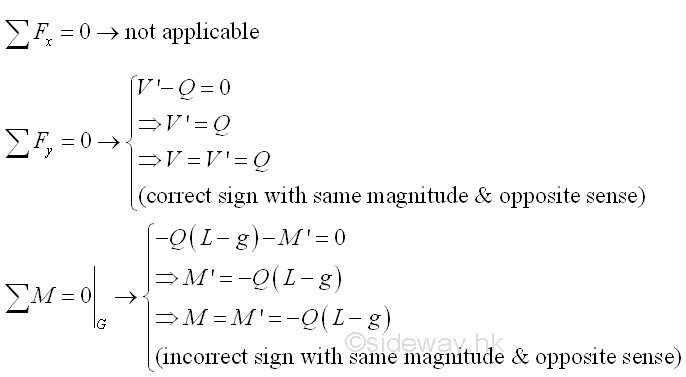
Point G is a random point between E and B. The shear force V is a constant and is equal to Q between point E and point G. And bending moment M is a linear function of point G. Therefore bending moment M=-Q(L-e) at point E and bending moment M=0 at point B. Assumption for Shear and Bending Moment DiagramsSince length L is greater than length e, the reaction force RA at point A may be negative if load Q term is greater than load P term. For normal practical applications, the reaction force RA at point A is usually pointing upward. Therefore, the reaction force RA at point A is assumed positive in plotting the shear and bending moment diagrams. 
Shear Diagram
Bending Moment Diagram
|
Sideway BICK Blog 24/08 |
||||||||||||||||||||||||||||||||||||||||||||||||||||||||||||||||||||||||||||||||||||||||||||||||||||||||||||||||||||||||||||||
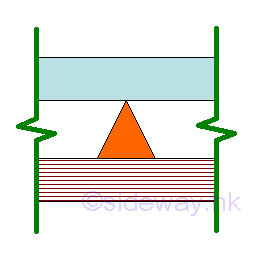 or
or
